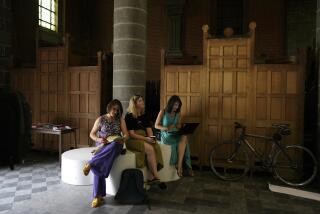Churches Converted to Flats : Some Britons Now Dwell in the House of the Lord
- Share via
LONDON — Twelve years after the church of St. Simon’s was last used as a place of worship, it has been given a new lease on life as a place to live.
The red brick neo-Gothic building in Maida Vale, west London, is among about 100 English churches declared superfluous by religious authorities and converted into private homes.
Real estate agents say aesthetically minded buyers looking for something different are lining up to enjoy the classic features of a church combined with a bold new idea for a modern dwelling.
“It’s appealing because it’s a trendy yet affordable way to live,” said Annabel Walker, who owns one of 12 apartments in St. Simon’s and wakes up under its original sloping roof beams.
“I don’t think about it as living in a church as such, but I love having the big mullion windows, the columns and arches right in my living room.”
Great Demand
Demand was so great that apartments in the church, now renamed Simon Court, were sold before being completed. Originally sold for between $55,000 and $83,000, their value has risen by 25% since the conversion a year ago.
Metamorphoses such as that at St. Simon’s became possible when the Church of England introduced a pastoral measure in 1969 declaring more than 1,000 of its 17,000 churches superfluous and allowing alternative uses of them.
Church attendance in Britain has been falling, and many small parishes have merged. Baptisms have nearly halved in the last 70 years, and confirmations are down by two-thirds.
The Church Commissioners say reaction to converting churches to condominiums has been positive.
“I think most people are glad to see the church at least put to good use,” said spokeswoman Rebecca David. “No one likes to see a church boarded up and vandalized.”
The Church Commissioners say no decision on the future of a church is taken without thorough consultation with local parishioners. And they say funds raised through the sale of an unused church are often used to maintain others still in use.
Other churches have become schools, meeting halls for civic and cultural activities, workshops, museums and sports centers.
Those converted to private dwellings have been sold to commercial developers, with the provisos that the building retain the appearance of a church and not be “used for any illegal or immoral purpose.”
Developers say other special conditions can sometimes make the Church of England an awkward vendor. One church failed to attract buyers because one condition of sale was that all bodies be removed from the crypt before the start of construction.
Another, on sale for a nominal sum, is unwanted because the adjoining churchyard is still in use. “No one likes to watch funerals from their living room window,” remarked one property analyst.
Architects seek to preserve as much of the traditional churches as possible. “We leave the arches, columns and brickwork,” said Fred Caswill, who designed Simon Court. “The timber stays exposed and we generally keep or renovate the original stained glass and mullion windows, though we aim to install double glazing.”
More to Read
Sign up for Essential California
The most important California stories and recommendations in your inbox every morning.
You may occasionally receive promotional content from the Los Angeles Times.












